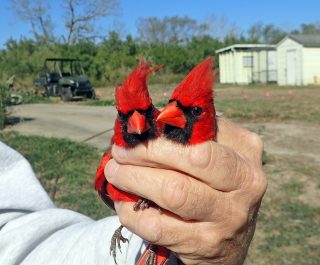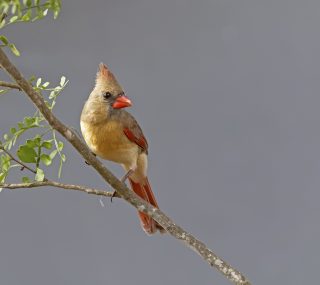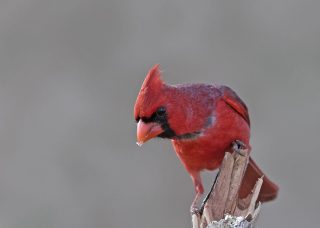
These two male cardinals are in the hand of the bander. Karen Benson photo.
Calling All Cardinals: Come and Be Counted
I was having a quiet breakfast when I heard the “thump.” Something had hit the kitchen window. Moments later another thump occurred. I knew that sound. It was the sound of a bird flying into the window glass. Given the early hour and the sun glint on the window, I suspected a small flock of sparrows had miscalculated and bounced of the reflected image of the sky.
I went outside to see. A female cardinal was lying on the ground at the bottom of the window. As I stepped closer, another bird flew away from the cardinal. It was bigger than a cardinal, mostly dark gray, and with a touch of white at the base of the tail. It was a Cooper’s Hawk. Cooper’s Hawks prey on small birds, ambushing them and occasionally chasing them. I could imagine the scene that just went down. The hawk flew out of the hackberry motte towards the bird feeder. It attacked the cardinal but the victim escaped…only to fly into the window in her haste to get away. Likely, the hawk also hit the window, but perhaps not as hard.
Not all “bird strikes” end up killing the bird. Sometimes the bird is just “knocked out.” If I observe the poor bird is still breathing, I put it in a quiet, dark place (like a cardboard box) and see if it will regain consciousness. Sometimes it does. Then I release it.
This female cardinal was not so lucky. Her neck had been broken by the impact. And both of her legs. What a hard hit! I looked over her battered body and noticed a curious glint of metal on one of her legs.

This female cardinal sports warm brown plumage with a bright orange bill. Robert Benson photo.
She was a banded bird. I copied down the number on the band: #991-48940. I remembered banding birds with my husband. I was often the recorder of the data when we banded. The prefix (the 991) seemed familiar. It was possible that we might have banded this cardinal here on our farm.
Banders meticulously record and submit all band numbers to the Bird Banding Lab. Their database is now quite large. If you contact the lab with a band number, they can tell you when and where the bird was banded. The banders also record other data. Typically, the sex, the age, the measurements, and the amount of fat reserves a bird has are also noted. Banding is a good way to learn about the lives and movements of birds.
We checked out the band number against the lab’s records. Sure enough, we had banded this female Northern Cardinal. Ten years ago! She had been banded right here next to this feeder on January 2, 2008. Her plumage at the time was that of an adult cardinal, so she was at least a year old at the time of banding. We could infer that this bird was at least eleven years old when she died. The oldest known banded Northern Cardinal had worn a band for fifteen years. Our deceased bird had lived a long life.
Our bird feeder attracts a lot of cardinals, especially in winter. I counted almost a dozen this morning. I had seen six males all at once. A few minutes later, I observed five females in the same tree. There were probably more around.
How many of these cardinals had we previously banded? The only way to know is to recapture them. We put the mist-net up and quickly caught three males. None of them was banded. Of course, it has been several years since we marked any cardinals on this property.

A male Northern Cardinal is a beautiful bird. Robert Benson photo.
An estimation of the population of a species can be made by capturing and marking the individual birds. Repeat the procedure a day or so later. You will capture some of the marked ones again. These are called “recaptures.” The number of recaptures divided by the original number captured gives you a rough percentage of the total number of individuals likely to be in that population. In other words, if we recaptured one bird out of ten originally marked, then we probably were only catching 10% of the whole population. If so, then our estimate would be ten times the ten of the original sample. Thus the population could be made up of 100 individuals. However, this is calculation implies that the area in which that population lives is closed to individuals moving in or out. (In other words, this method would work best for fish in a pond!)
Here is my proposed experiment. For two hours, I will capture and band cardinals. The mist-net will be set up next to the feeder and the brushy motte where they hide. It must be during the morning hours as afternoon sun makes the nearly invisible mist-net visible to the birds and they avoid it. I will repeat the trapping protocol for two hours the next morning. My numbers of captures/recaptures will produce an estimate of how many cardinals use the feeder motte. Of course, it won’t be a completely valid estimate of how many actually live close to my house, since birds could be coming and going from much further away. Still, it could be interesting. What is your guess? Do I have only a dozen cardinals? Two dozen? A hundred?
Column by Karen L. P. Benson
